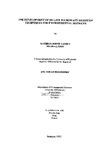THE DEVELOPMENT OF ON-LINE MICROWAVE DIGESTION TECHNIQUES FOR ENVIRONMENTAL MATRICES
| dc.contributor.author | LAMBLE, KATHRYN JUDITH | |
| dc.contributor.other | School of Geography, Earth and Environmental Sciences | en_US |
| dc.date.accessioned | 2013-09-24T09:22:15Z | |
| dc.date.available | 2013-09-24T09:22:15Z | |
| dc.date.issued | 1997 | |
| dc.identifier | NOT AVAILABLE | en_US |
| dc.identifier.uri | http://hdl.handle.net/10026.1/1908 | |
| dc.description.abstract |
As a consequence of our advancing knowledge of the impact of trace elements in environmental and biological systems there is increasing need for quantitative analytical techniques to accurately, sensitively and rapidly determine a wide range of trace elements in environmental samples. Since their emergence in 1975 microwave digestion techniques have revolutionised conventional approaches to sample digestion and have rapidly gained widespread acceptance as an effective method of sample preparation. This thesis describes how a number of novel on-line microwave digestion techniques have been developed, characterised and applied to the digestion of a range of environmental matrices which have proved time consuming or troublesome to digest by conventional techniques. A variety of batch open focused microwave digestion methods have been developed and utilised for the analysis of a range of environmental samples including tea leaves, seaweed and sediment samples. The techniques were optimised to determine a range of trace metals including Al, As, Ba, Ca, Cr, Cu, Fe, K, Mg, Mn, Pb, Ni, Ti, V and Zn and in each case were successfully validated by the analysis of suitable certified reference materials. These techniques demonstrated a number of advantages over conventional methods including less reagent usage, less contamination and substantial time savings. Speciation studies have been a focus for this work and have included the evaluation of an acetic acid microwave extraction method for the extraction of tributyltin, dibutyltin, monobutyltin and triphenyltin from sediment samples prior to analysis by high performance liquid chromatography-inductively coupled plasma-mass spectrometry (HPLC-ICP-MS). In addition the speciation of arsenic in biological samples was addressed by the development and evaluation of an on-Une microwave digestion technique. This enabled the speciation of arsenobetaine (AsBet), monomethylarsonic acid (MMA), dimethylarsinic acid (DMA) and inorganic arsenic following their separation by HPLC. Decomposition was achieved by microwave digestion and followed by pre-reduction with L-cysteine and detection by hydride generation-atomic absorption spectrometry. Simple modification of the technique also facilitated the determination of total arsenic. In addition the total reducible arsenic species (inorganic arsenic, MMA and DMA) were determined directly by on-line pre-reduction-HG-AAS. The results obtained were in good agreement with the certified values for the reference materials NRCC DORM-1 (dogfish muscle) and TORT-1 (lobster hepatopancreas). The on-line microwave digestion approach was further developed for the determination of the total mercury content of solid environmental samples. This involved the combination of an on-line microwave digestion and a bromide/bromate oxidation reaction to facilitate complete oxidation of the organomercury species in slurried biological samples. Following this approach detection could be performed by cold vapour-atomic fluorescence spectrometry, giving a limit of detection of 13 ng l-1. In addition a batch method in which samples were digested with a mixture of hydrogen peroxide, nitric acid and sulphuric acid was developed and studied using temperature profile measurements. Both methods were successfully validated by analysis of the certified reference materials NRCC DORM-2 and PACS-1 (harbour marine sediment). | en_US |
| dc.description.sponsorship | Prolabo Ltd, Paris, France | en_US |
| dc.language.iso | en | en_US |
| dc.publisher | University of Plymouth | en_US |
| dc.title | THE DEVELOPMENT OF ON-LINE MICROWAVE DIGESTION TECHNIQUES FOR ENVIRONMENTAL MATRICES | en_US |
| dc.type | Thesis | en_US |
| plymouth.version | Full version | en_US |
| dc.identifier.doi | http://dx.doi.org/10.24382/1396 | |
| dc.identifier.doi | http://dx.doi.org/10.24382/1396 |
Files in this item
This item appears in the following Collection(s)
-
01 Research Theses Main Collection
Research Theses Main


